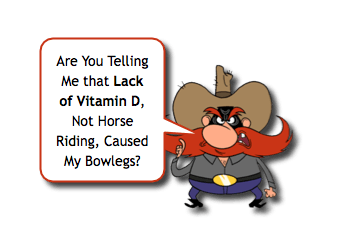Rickets Presentations in the ED
 In the Emergency Department, we are constantly juggling large lists of differential diagnoses. We become facile at sorting through the vast Ddx for seizures (ex, simple febrile seizures, complex seizures, neonatal seizures, eclampsia, seizure mimics) and syncope (ex, hair grooming syncope, Brugada, prolonged QTc, breath holding spell). We also are painfully aware that even fractures deserve more attention than describing what bone is broken (ex, wrist, supracondylar, pelvic, toddler’s). Unfortunately, we have to contemplate the potential for a patient presenting because of abuse. Interestingly, there is one condition that should be added to the Ddx list of each of these scenarios – Rickets:
In the Emergency Department, we are constantly juggling large lists of differential diagnoses. We become facile at sorting through the vast Ddx for seizures (ex, simple febrile seizures, complex seizures, neonatal seizures, eclampsia, seizure mimics) and syncope (ex, hair grooming syncope, Brugada, prolonged QTc, breath holding spell). We also are painfully aware that even fractures deserve more attention than describing what bone is broken (ex, wrist, supracondylar, pelvic, toddler’s). Unfortunately, we have to contemplate the potential for a patient presenting because of abuse. Interestingly, there is one condition that should be added to the Ddx list of each of these scenarios – Rickets:
Rickets: Basics
- Rickets is soften or weakening of the bones due to poor mineralization.
- Often due to Vitamin D deficiency.
- May also have Vitamin D resistance.
- Rickets has actually had an increase in prevalence [Lazol, 2008]
- May be due to increase in breast-feeding, low calcium and Vitamin D intake, or decrease sun-exposure (ex, increase use of sunscreen, decreased time spent outside).
- Congenital rickets is also a problem related to maternal vitamin D deficiency.
- Types of Vitamin D [Bloom, 2004]
- Vitamin D2 is obtained from dietary sources.
- Vitamin D3 is generated by the skin from sun exposure.
- Vitamin D2 and D3 are converted to 25-hydoxyvitamin D in the liver.
- Low 25-hydroxyvitamin D is most specific testing for vitamin D deficient Rickets.
- The kidney then converts this form to 1,25-hyoxyvitamin D.
- Vitamin D is important! [Bloom, 2004]
- It is necessary for the absorption of dietary calcium and phosphorus.
- Mobilizes calcium and phosphorus from bones as well (with help of parathyroid hormone).
Vitamin D Deficiency Causes:
[Zurlo, 2012; Bloom, 2004]
- Low sunlight exposure
- Poor dietary intake of Vitamin D
- Poor GI absorption of Vitamin D (ex, Celiac Disease)
- Liver Disease – impairs conversion of Vitamins D2 and D3
- Renal Disease – impairs conversion to 1,25-hyoxyvitamin D
- Medications, like phenytoin, can impair Vitamin D metabolism.
- Defects in 1-alpha-hydroxylase (enzyme that generates 1,25-hyoxyvitamin D)
- Vitamin D receptor abnormalities
Pathophysiologic Consequences:
- Low vitamin D level (or effect) leads to decreased GI calcium absorption
- Low calcium absorption leads to low serum calcium levels which increases parathyroid hormone.
- Increased parathyroid hormone mobilizes calcium from bone to help improve serum calcium levels.
- Continued elevated parathyroid hormone causes hypophosphatemia.
- Persistent low vitamin D eventually leads to low serum calcium and elevated serum alkaline phosphatase.
Rickets: Presentations in the ED
- Typically presents in patients 5 to 25 months of age.
- Can present earlier (even in neonates) when associated with maternal vitamin D deficiency or resistance.
- Manifests in a variety of manners.
- Bony Changes
- Thin bone cortex (osteopenia) and Fractures
- May present for fractures and lead to concern for abuse
- Seen in ~25% of cases in one study [Lazol, 2008]
- Widening and fraying of metaphysis (seen ~75% of cases) [Lazol, 2008]
- May present with swollen / painful joints [Ben-Yakov, 2017]
- Rachitic Rosary of the ribs (seen ~60% of cases) [Lazol, 2008]
- Lower extremity bowing (bones unable to support child’s weight) (seen ~60% of cases) [Lazol, 2008]
- Delayed dental eruption
- Delayed fontanelle closure (~5% of cases) [Lazol, 2008]
- Poor linear growth (~3% of cases) [Lazol, 2008]
- Thin bone cortex (osteopenia) and Fractures
- Metabolic Changes
- Tetany from hypocalcemia
- Seizures from hypocalcemia (~30% of cases) [Lazol, 2008; Bellazzini, 2005]
- Prolonged QTc from hypocalcemia
- Incidental Findings on X-rays. [Hickey, 2006]
- Bony Changes
Rickets Therapy
- Seizure or tetany
- Intravenous calcium
- Fractures, bony abnormalities, or growth problems
- Oral dihydroxyvitamin D
- Increase dietary intake of calcium (possible additional calcium supplement)
Moral of the Morsel
- Vitamins are important! Even for emergency medicine providers to know about!
- Add it to the list! Consider Rickets and Hypocalcemia on the Ddx for patients with Seizures, Tetany, or fractures and possible NAT.
- Look closely at those X-rays! Incidental findings can make a big difference!


There indeed people with metabolic disorders unable to metabolise things like D, K, calcium, magnesium and these can cause excesses and deficiencies.